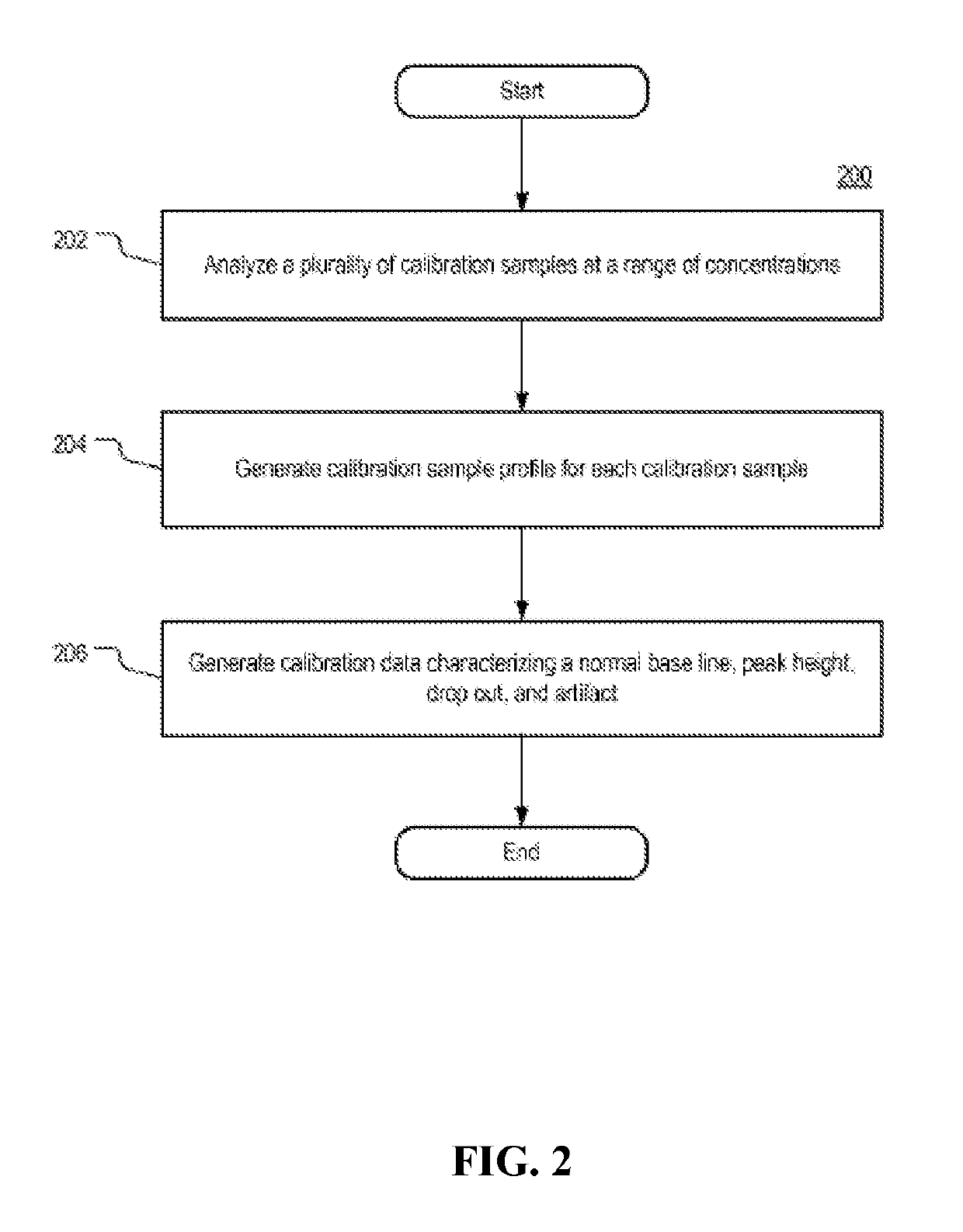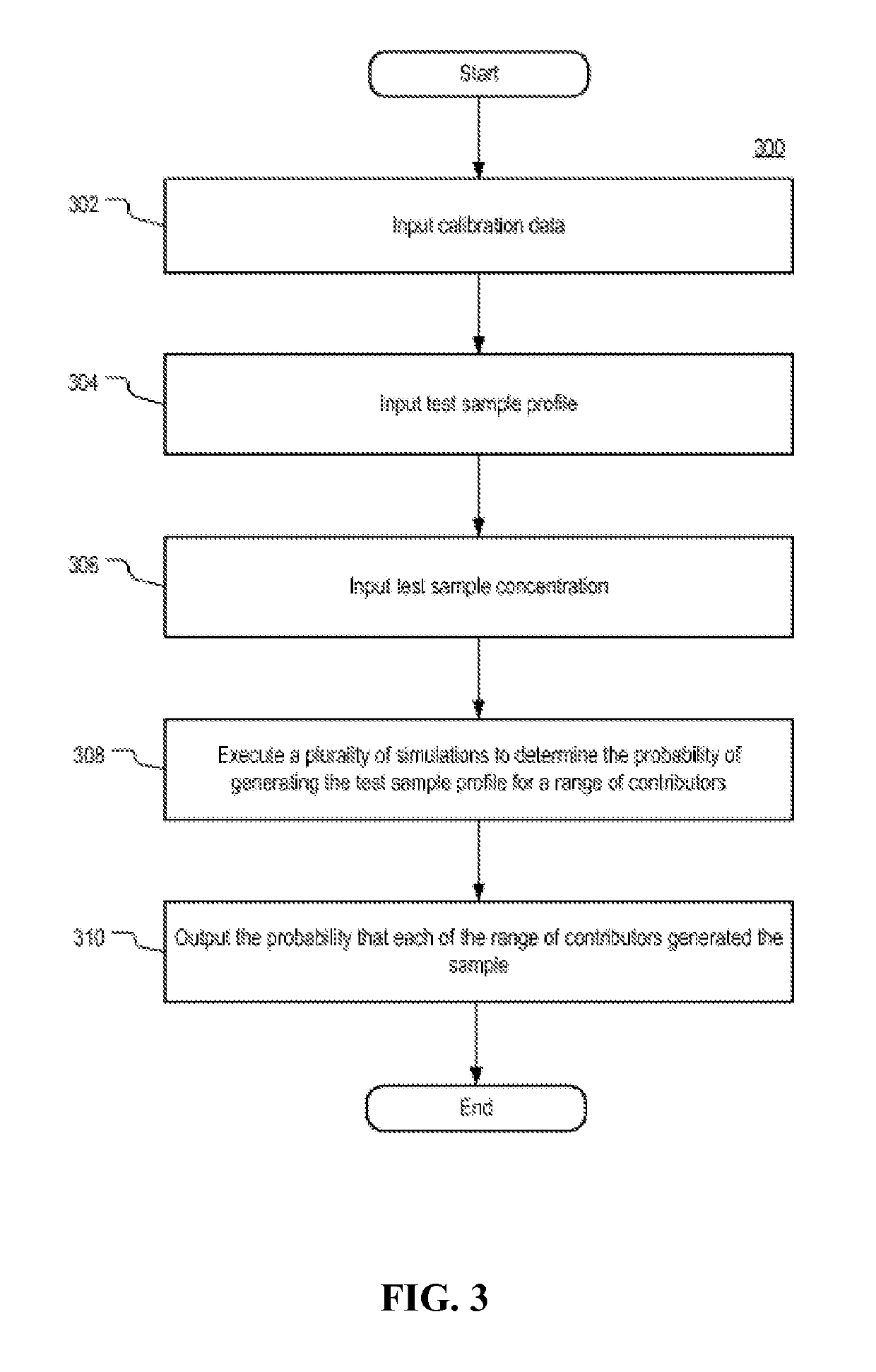Systems and methods for determining an unknown characteristic of a sample
a technology of unknown characteristics and systems, applied in biostatistics, biochemistry apparatus and processes, instruments, etc., can solve problems such as difficult to interpret low-template, problems such as allele detection (dropout), and problems such as the association of alleles
- Summary
- Abstract
- Description
- Claims
- Application Information
AI Technical Summary
Benefits of technology
Problems solved by technology
Method used
Image
Examples
example 1
n of Calibration Samples
[0056]To generate the calibration samples, high molecular weight DNA was extracted from 35 single source samples using standard organic extraction procedures. The samples were whole blood, dried blood stains or saliva. The blood stains were either on Whatman® paper or cloth swatches. Saliva samples were either whole saliva or dried buccal swabs on cotton. Briefly, the organic extraction consisted of incubating the sample in 300 μg / mL of Proteinase K and 2% v / v SDS (sodium dodecyl sulfate) solution at 37° C. for 2 hours to overnight. Purification was accomplished with phenol / chloroform and alcohol precipitation. The DNA was dissolved in 50 μl of TE buffer (10 mM Tris, 0.1 mM EDTA, pH 8.0) at 56° C. for 1 hour. Absolute DNA quantification was performed using real-time PCR and the Quantifiler® Duo™ Quantification kit according to the manufacturer's recommended protocol and one external calibration curve. A 7500 Sequence Detection System (Life Technologies, Inc.)...
example 2
-Person Experimental Samples
Methods
[0057]1-, 2-, 3-, 4- and 5-person experimental samples were used for testing, FIG. 5, referred to as Testing Set 1. These 1-person samples were created using the same protocol described for the samples in the calibration set. The mixtures were created by mixing appropriate volumes of the single source DNA extracts to attain the various ratios specified in the following table:
[0058]
TABLE 1The Mixture Ratios Used to Create Samples in Testing Set 1Number of ContributorsMixture ratios used21:1, 1:2, 1:4, 1:9, 1:1931:1:1, 1:2:1, 1:4:1, 1:9:1, 1:2:2, 1:4:4, 1:9:941:1:1:1, 1:1:2:1, 1:1:4:1, 1:1:9:1, 1:2:2:1, 1:4:4:1, 1:9:9:151:1:1:1:1, 1:1:2:1:1, 1:1:4:1:1, 1:1:9:1:1, 1:1:2:2:1,1:1:4:4:1, 1:2:2:2:1, 1:4:4:4:1
[0059]Once mixed, these samples were re-quantified and then amplified using the same target masses used for the single-source samples. In the case of mixtures, the samples were created using various kinds of mixture ratios in such a way that each indi...
example 3
son Experimental Studies
[0085]The performance of the disclosed method and system is tested on 1 person (the calibration source), 2 person and 3 person mixtures. MAC and MLE were also run on the same set of samples for comparison purposes. The following table shows the number of samples used at the different DNA amounts for each time of injection:
[0086]
TABLE 4Total Number of Samples, 1,2,3-Person Experimental StudiesNumber of Contributors123DNAInjectionInjectionInjectionAmountTimesTimesTimes(ng)5102051020510200.0077495745557770.0167295745557770.0317289745557770.0477374735557770.0627492755557770.1257392725557770.250749574555777Total5126325163535354949491660105147
[0087]MAC and MLE were evaluated using a threshold of 50 RFU, the most commonly used threshold. Overall the disclosed method and system exhibits a higher accuracy rate (95%) compared to both MAC (84%) and MLE (53%) across all samples tested.
PUM
| Property | Measurement | Unit |
|---|---|---|
| pH | aaaaa | aaaaa |
| volume | aaaaa | aaaaa |
| volume | aaaaa | aaaaa |
Abstract
Description
Claims
Application Information
 Login to View More
Login to View More - R&D
- Intellectual Property
- Life Sciences
- Materials
- Tech Scout
- Unparalleled Data Quality
- Higher Quality Content
- 60% Fewer Hallucinations
Browse by: Latest US Patents, China's latest patents, Technical Efficacy Thesaurus, Application Domain, Technology Topic, Popular Technical Reports.
© 2025 PatSnap. All rights reserved.Legal|Privacy policy|Modern Slavery Act Transparency Statement|Sitemap|About US| Contact US: help@patsnap.com



